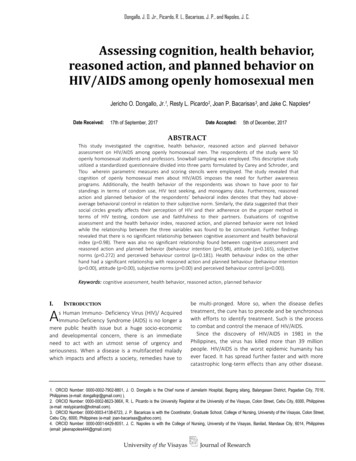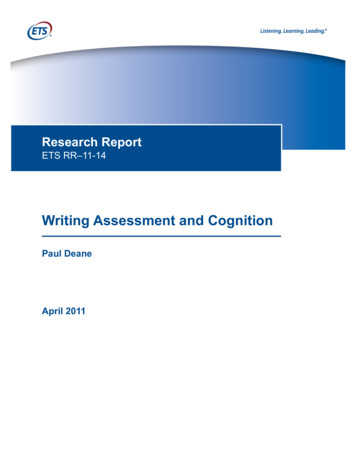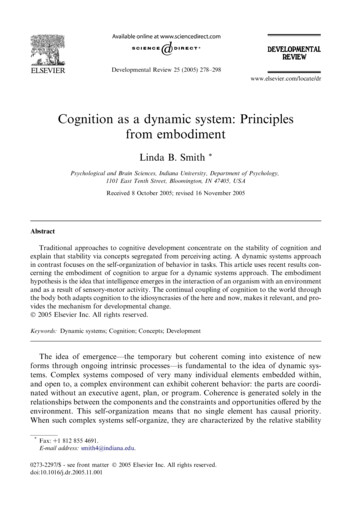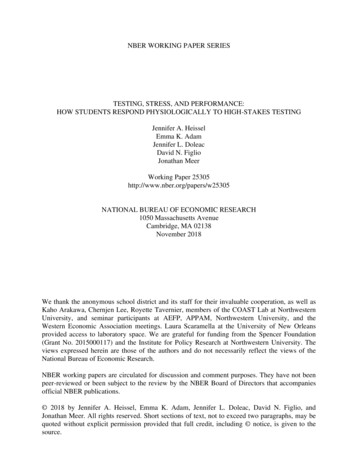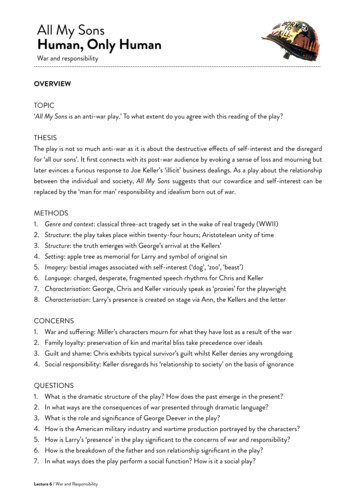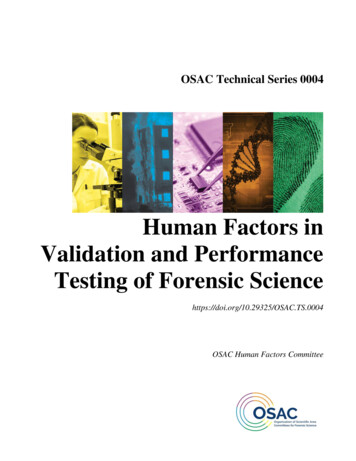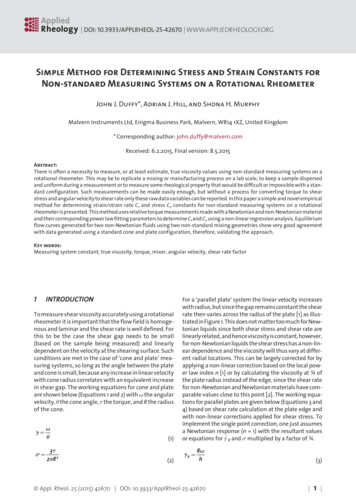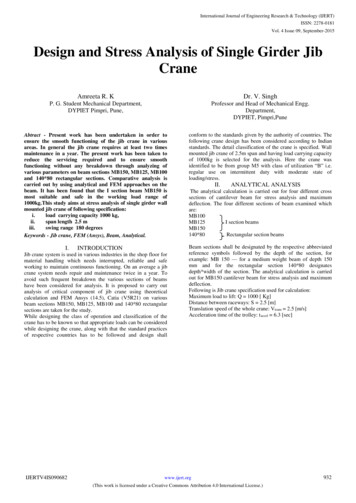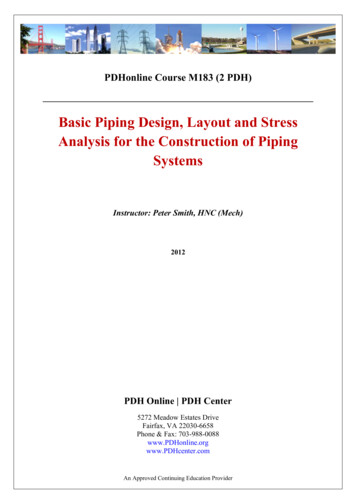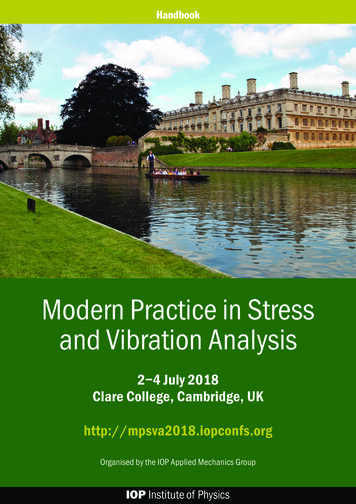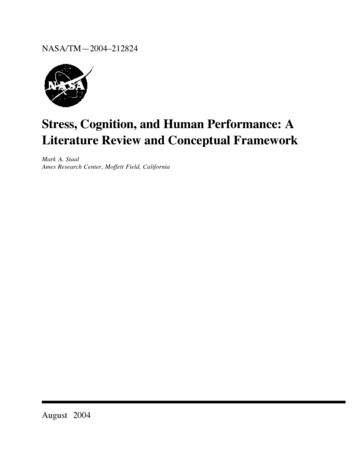
Transcription
NASA/TM—2004–212824Stress, Cognition, and Human Performance: ALiterature Review and Conceptual FrameworkMark A. StaalAmes Research Center, Moffett Field, CaliforniaAugust 2004
The NASA STI Program Office . in ProfileSince its founding, NASA has been dedicated tothe advancement of aeronautics and spacescience. The NASA Scientific and TechnicalInformation (STI) Program Office plays a keypart in helping NASA maintain this importantrole.The NASA STI Program Office is operated byLangley Research Center, the lead center forNASA’s scientific and technical information.The NASA STI Program Office provides accessto the NASA STI Database, the largestcollection of aeronautical and space science STIin the world. The Program Office is alsoNASA’s institutional mechanism fordisseminating the results of its research anddevelopment activities. These results arepublished by NASA in the NASA STI ReportSeries, which includes the following reporttypes: TECHNICAL PUBLICATION. Reports ofcompleted research or a major significantphase of research that present the resultsof NASA programs and include extensivedata or theoretical analysis. Includescompilations of significant scientific andtechnical data and information deemed tobe of continuing reference value. NASAcounterpart of peer-reviewed formalprofessional papers, but having lessstringent limitations on manuscript lengthand extent of graphic presentations.TECHNICAL MEMORANDUM.Scientific and technical findings that arepreliminary or of specialized interest, e.g.,quick release reports, working papers, andbibliographies that contain minimalannotation. Does not contain extensiveanalysis.CONTRACTOR REPORT. Scientific andtechnical findings by NASA-sponsoredcontractors and grantees. CONFERENCE PUBLICATION.Collected papers from scientific andtechnical conferences, symposia,seminars, or other meetings sponsoredor co-sponsored by NASA. SPECIAL PUBLICATION. Scientific,technical, or historical information fromNASA programs, projects, and missions,often concerned with subjects havingsubstantial public interest. TECHNICAL TRANSLATION.English-language translations of foreignscientific and technical materialpertinent to NASA’s mission.Specialized services that complement the STIProgram Office’s diverse offerings includecreating custom thesauri, building customizeddatabases, organizing and publishing researchresults . even providing videos.For more information about the NASA STIProgram Office, see the following: Access the NASA STI Program HomePage at http://www.sti.nasa.gov E-mail your question via the Internet tohelp@sti.nasa.gov Fax your question to the NASA STIHelp Desk at (301) 621-0134 Telephone the NASA STI Help Desk at(301) 621-0390 Write to:NASA STI Help DeskNASA Center for AeroSpaceInformation7121 Standard DriveHanover, MD 21076-1320
NASA/TM—2004–212824Stress, Cognition, and Human Performance: ALiterature Review and Conceptual FrameworkMark A. StaalAmes Research Center, Moffett Field, CaliforniaNational Aeronautics andSpace AdministrationAmes Research CenterMoffett Field, California 94035August 2004
Available from:NASA Center for AeroSpace Information7121 Standard DriveHanover, MD 21076-1320301-621-0390National Technical Information Service5285 Port Royal RoadSpringfield, VA 22161703-605-6000This report is also available in electronic form lications/publications.php
ContentsIntroduction .1What is Stress? .1Theoretical Perspectives.2Arousal, Activation, and Energetical Theories.2Yerkes-Dodson and Arousal Theory.2The Infamous Inverted U .3Theoretical Perspectives of Resource Theory and Activation.9Energetical Models.12Direct and Indirect Effects of Putative Stressors.14Workload as a Substitute for Stress .14Measurement of Stress and Workload.16Summary of Findings and Limitations to the Literature.20Evaluation and Appraisal Systems.20Cognitive Appraisal and the Transactional Model.20The Evaluative Reflex.20Higher-order Cognition and Stress .21Biological and Neurological Bases.23Predictability and Controllability.25Cognitive Appraisal and Attentional Bias.26Summary of Findings and Limitations to the Literature.27The Effect of Stress on Attention.31Pre-Attentive Processing and the Orienting Reflex.31The Tunnel Hypothesis.33Vigilance and Sustained Attention.37Attentional Workload and Resource Allocation.39Attentional Theories and Perspectives.41Summary of Findings and Limitations to the Literature.44The Effect of Stress on Memory.45Working Memory Overview .45Memory, Stress Effects, and Anxiety.46What Mechanisms Explain the Anxiety-Memory Deficit?.47Memory and Other Putative Stressors.49Stress, Cortisol, and Memory.51Emotional Memories, Trauma, and Tunneling.52Learning, Practice, and the role of Automaticity.57Summary of Findings and Limitations to the Literature.60The Effects of Stress on Perceptual-Motor Performance .63Summary of Findings and Limitations to the Literature.66The Effects of Stress on Judgment and Decision Making.68Theoretical Models of Judgement and Decision Making .68The Role of Experience in Judgment and Decision Making .74Team Judgment and Decision Making .75Summary of Findings and Limitations to the Literature.76The Effects of Putative Stressors on Performance.80The Effects of Workload (Work Volume, Concurrent Task Management, and Task Switching).81The Effects of Time Pressure on Performance.84The Effects of Thermal Stress (Heat and Cold) on Performance.86v
The Effects of Noise on Performance.88The Effects of Fatigue on Performance.92Moderator Factors and the Effects of Stress on Performance.96The Presence of Others .96Social Facilitation and Prosocial Behavior .97Group Member Status.97Personality.97Emotional Awareness.98Additional Areas of Discussion.98Stress Interventions .98Stress Inoculation Training.98Stress Management Programs.100Critical Incident Stress Management / Psychological Debriefing .102The Speed / Accuracy Trade-Off Effect .104Laboratory versus Real-World Research Designs .104The Biology and Neuro-anatomy of the Human Stress Response .107Limitations of the Review and Questions left Unanswered .111The Conceptual Framework of Information Processing under Stress.113References.116Appendix A: Cognitive Appraisal Processing Elements.164Appendix B: Cognitive Stress Intervention Model (Restructuring and Inoculation) .165Appendix C: Attentional and Memory Processing under Stress.166Appendix D: Stress Effects on Information Processing (brief outline).167Appendix E: Stress Effects on Information Processing (expanded outline) .168vi
TablesNumberPageTable 1. Andre’s Measurements of Task Demands . .18Table 2. Hilburn and Jorna’s Air Traffic Control workload measures .19Table 3. Cognitive Appraisal and Performance Enhancement .30Table 4. Studies in Support of the Tunnel Hypothesis .36Table 5. Studies Showing Negative Effects of Stress on Attention .43Table 6. Studies Showing Negative Effects of Stress on Memory. .61Table 7. Studies Showing Negative Effects of Stress on Perceptual-Motor Performance.67Table 8. Studies Showing Negative Effects of Stress on Judgment & Decision Making .78Table 9. Questions that Remain Unanswered.112FiguresNumberPageFigure 1. The Yerkes-Dodson Principle .4Figure 2. Positive, Negative, and Null Curvilinear Relationships.8Figure 3. Hilburn and Jorna’s Framework of Task load and Workload .19Figure 4. Baddeley’s Model of Working Memory .45Figure 5. Neuro-Physiological Elements in the Human Stress Response.108vii
IntroductionThe following literature review addresses the effects of various stressors on cognition. Whileattempting to be as inclusive as possible, the review focuses its examination on the relationshipsbetween cognitive appraisal, attention, memory, and stress as they relate to information processingand human performance. The review begins with an overview of constructs and theoreticalperspectives followed by an examination of effects across attention, memory, perceptual-motorfunctions, judgment and decision making, putative stressors such as workload, thermals, noise, andfatigue and closes with a discussion of moderating variables and related topics. In summation of thereview, a conceptual framework for cognitive process under stress has been assembled. As one mightimagine, the research literature that addresses stress, theories governing its effects on humanperformance, and experimental evidence that supports these notions is large and diverse. Inattempting to organize and synthesize this body of work, I was guided by several earlier efforts(Bourne & Yaroush, 2003; Driskell, Mullen, Johnson, Hughes, & Batchelor, 1992; Driskell & Salas,1996; Handcock & Desmond, 2001; Stokes & Kite, 1994). These authors should be credited withaccomplishing the monumental task of providing focused reviews in this area and their collectiveefforts laid the foundation for this present review. Similarly, the format of this review has beendesigned in accordance with these previous exemplars. However, each of these previous efforts eithersimply reported general findings, without sufficient experimental illustration, or narrowed their scopeof investigation to the extent that the breadth of such findings remained hidden from the reader.Moreover, none of these examinations yielded an architecture that adequately describes or explainsthe inter-relations between information processing elements under stress conditions. It is the author’shope that this review may provide an initial step toward this end.What is Stress?It’s a question that has beguiled many prominent researchers of this era. The term itself is amorphousand sustains the difficulty in discerning its meaning. Definitions of stress range from metallurgicalstrain to one’s emotional wits end. Although convergence on a common definition of stress is highlydesirable, the scientific community has not been able to do so. Instead, the research literature reflectswide and divergent opinions concerning stress.Stokes and Kite (2001) suggest that the term’s versatility (its range of application), is its undoing as auseful scientific term or concept, and they are not alone in this assertion (Tepas & Price, 2001).Accordingly, stress can be viewed as, “ an agent, circumstance, situation, or variable that disturbs the‘normal’ functioning of the individual stress [is also] seen as an effect—that is the disturbed stateitself this bifurcation of meaning is arguably the most fundamental source of the confusionsurrounding the stress concept.” (p. 109). Stokes and Kite contend that there are no psychologicalstressors in any absolute, objective sense.In their review of the construct and its evolution, they assert that there are two traditional models ofpsychological stress, stimulus-based and response-based. The stimulus-based stress approach assumescertain conditions to be stressful and dubs these stressors (i.e., workload, heat and cold, time pressure,etc.). Historically this has resulted in researchers selecting such exogenous variables, applying themexperimentally, and concluding that the outcome witnessed was likely the result of a “stress”manipulation. The approach is based on an engineering analogy (mechanical stress and emotionalstrain) that Stokes and Kite contend is inadequate. They argue that this model ignores individualdifferences, does not evaluate circumstances, and leaves out emotion—we are not just machines thatreact to environmental stimuli.
The response-based stress approach holds that stress is defined by the pattern of responses (i.e.,behavioral, cognitive, and affective) that result from exposure to a given stressor. In contrast to thestimulus-based approach, these variables can be considered endogenous or coming from within theindividual. This model has relied heavily on the work of Yerkes and Dodson (1908) and later Selye(1956) and found its emphasis in physiological dimensions (this evolution is described in more detailin the following section).Stokes and Kite (2001) suggested that physiological measures have failed to provide a completeunderstanding of the human stress response and do not necessarily equate to psychological stress, andthus a third approach to understanding the human stress response has emerged—the transactionalmodel. Transactional models view stress as the interaction between the environment and individual,emphasizing the role of the individual’s appraisal of situations in shaping their responses. From thetransactional approach, stress is defined as, “ the result of a mismatch between individuals’perceptions of the demands of the task or situation and their perceptions of the resources for copingwith them.” (p. 116). The fundamental assumptions underlying this approach are discussed ingreater detail during a review of the cognitive appraisal literature.There seem to be as many definitions of stress as there are stress researchers. Adding to the difficultyin finding an adequate definition for stress is the fact that the term is used in association with so manydifferent constructs. For instance, Tepas and Price (2001) suggested that stress is commonlyconnected to the following concepts: adaptation, anxiety, arousal, burnout, coping, exertion,exhaustion, exposure, fatigue, hardiness, mental load, repetitiveness, strain, stressor, and tension. Giventhe formidable breadth of the domain it is not difficult to see why stress as a construct has becomeunwieldy for most researchers.For the sake of simplicity and coherence, I have selected a definition proposed by McGrath (1976)that seems to be broad enough to incorporate most
Help Desk at (301) 621-0134 Telephone the NASA STI Help Desk at (301) 621-0390 Write to: NASA STI Help Desk NASA Center for AeroSpace Information . heat and cold, time pressure, etc.). Historically this has resulted in rese
